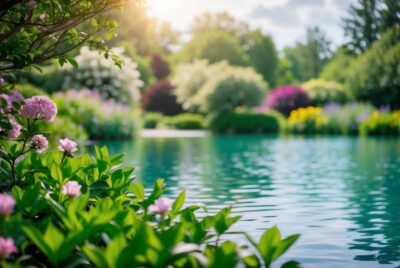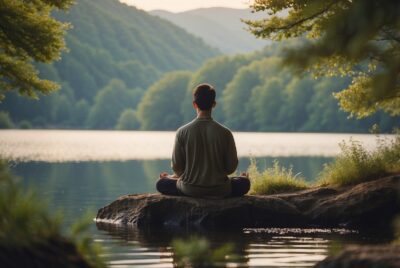Meditation Art: Deepening the Inner Journey
*We may earn a commission for purchases made using our links. Please see our disclosure to learn more.
Meditation Art: Unveiling Its Impact on Mindfulness and Creativity
I find that Meditation Art is a unique fusion of two ancient practices: meditation and art creation. This practice offers a holistic approach to well-being by combining the calming benefits of meditation with the expressive joys of art. As a practitioner, I focus on inner tranquility and allow that sense of peace to guide my artistic expression. The process itself is meditative, as I immerse in the flow of creativity, often leading to a deep sense of relaxation and a heightened awareness of the present moment.

My experience with Meditation Art has shown that it can be particularly effective for overcoming creative blockades. It allows the artist to shift their focus away from the stresses and pressures associated with the outcome of the creative work. Instead, my attention centers on the process of creation, which is where the meditative aspect comes into play. Embracing this practice, I’ve found that the act of creating art can become a vehicle for mindfulness, self-connection, and contemplation.
As I’ve come to learn, Meditation Art isn’t restricted to any specific medium or technique, making it accessible to anyone regardless of their artistic skill level. Whether I’m engaged in drawing, painting, sculpting, or any other form of artistic expression, the emphasis remains on the process rather than the final product. This focus helps in cultivating a mental space where creativity can flow freely, unimpeded by judgment or expectation, and allows me to express my inner world in a way that is both therapeutic and fulfilling.
Foundations of Meditation Art

In exploring the intersection of meditation and art, we uncover a rich tapestry of history, diverse practices, and profound impacts on both creators and observers.
Historical Roots
Buddhism has long integrated artistic endeavors with spiritual practice. The earliest Buddhist art reflects the use of visual aids to convey religious teachings and aid in meditation. Buddhist meditation, with its focus on mindfulness and the present moment, has been expressed through various art forms for centuries, making it a transformative aspect of the tradition.
Defining Meditation Art
Meditation art is the creative manifestation that arises from an intimate connection with the present moment and awareness. It’s a process where an individual’s focus and concentration work in tandem with their breathing, often leading to a state of flow—marked by a sense of tranquility and deep engagement with one’s emotions and artistic expression.
The Role of Mindfulness
Mindfulness is a core element in meditation art, cultivating a heightened state of awareness and presence. This practice has roots in traditions like yoga and Buddhist meditation, emphasizing the importance of silence and attentive observation. Whether one is creating or experiencing art, mindfulness can transform the act into a spiritual practice.
Understanding the Meditation Process
Engaging in the meditation process involves several stages: setting an intention, achieving focus through practices like concentration on the breath, entering a state of absorption where external distractions fade, and closing with reflection. This sequence allows for deep self-expression and a connection with one’s inner self.
Meditation and Creativity
Creativity in the context of meditation art is not just about producing something aesthetically pleasing; it’s about the authentic and spontaneous expression that emerges from a mind stilled by meditative practice. Emotions channeled through such a state can yield art that’s both personal and transformative.
Artistic Mediums and Practices
Meditation art can be crafted through a variety of mediums:
- Painting: Fluid strokes that reflect the artist’s inner world.
- Sculpture: Shapes in metal, stone, or clay forged in contemplative stillness.
- Photography: Capturing the ephemeral yet eternal beauty of the present moment.
- Craft: Each stitch or cut represents a mindful action, an act of focus.
- Writing: Words flow from a place of deep concentration and silence.
- Listening to music: Absorbing sounds as a means to anchor in the now.
Each medium offers a different path to the same destination: the convergence of creativity and calm awareness.
Engaging with Meditation Art

When I engage with meditation art, it involves a blend of interaction, personalized practices, and the utilization of public spaces designed for reflective experiences. Here’s how these dimensions shape my encounter with meditation art.
Interactive Components
In workshops, I often find the interactive components crucial for the meditative art experience. For example:
- Group Activities: I participate in guided sessions like yin yoga or movement exercises related to the meditation art.
- Tangible Interactions: I interact with site-specific installations, where the tactile experience intensifies my connection with the artwork.
Meditation Art in Public Spaces
Meditating in public spaces like museums or galleries brings a unique dimension to my practice. Here’s how:
- Museum/Gallery: I seek out places that offer a sanctuary-like environment, where the ambience supports my meditation journey.
- Site-specific Works: I explore galleries hosting site-specific creations that foster a sense of ritual and reflection, minimizing distractions and promoting relaxation.
Personal Practices and Spaces
Creating a personal meditation space is central to deepening my practice. I consider:
- Sanctuary: My home space mirrors a sanctuary, a tranquil environment with artwork that calms my mind.
- Yoga and Movement: Integrating yoga or simple movement in my sanctuary enhances my focus and bodily awareness during meditation.
- Distraction-Free: Ensuring my personal space is free from distractions is pivotal for my relaxation and mindfulness.
Appreciation and Critique

Meditation Art offers a unique blend of aesthetic appeal and spiritual practice, often provoking both admiration and critical analysis. Here, I discuss the intricacies of engaging with Meditation Art from an observer’s standpoint, dissect its creative aspects, and highlight prominent contributors to the field.
The Viewer’s Experience
When I approach Meditation Art, I engage in a holistic sensory experience. Awareness of the present moment is paramount; it’s about anchoring myself in the ‘now’ and observing emotions as they arise. I aim to maintain the role of an observer, allowing empathy and reaction to interplay without judgment. Colors, shapes, and details are not just visual elements; they become reflective tools that guide my internal exploration.
Analyzing Meditation Art
In critiquing Meditation Art, I move beyond the standard artistic parameters of patterns and textures. Analysis involves understanding the art’s intention to evoke mindfulness. By dissecting these pieces, I take note of how the medium, whether it be sculpture influenced by the Buddha or abstract paintings, facilitate art as meditation. I consider the artist’s ability to transcend normal artistic boundaries to create something that fosters spiritual practice.
Prominent Artists and Influential Works
Several artists stand out when I consider Meditation Art. Their works often emerge as not just art pieces, but as tools for spiritual practice. For instance, a piece that simplifies form down to a singular point may draw my mind into a meditative state, reflecting the minimalistic teachings of Buddhist meditation. Yet, the role of the critic is not surrendered; I continually assess the empathy invoked by the artist, the emotional range, and the alignment between the artwork’s purpose and its effect on the observer.
Integration of Meditation Art in Wellness

I understand that incorporating meditation art into wellness initiatives can offer transformative experiences that enhance relaxation, foster empathy, and promote self-expression. Here, the focus lies on articulating how this integration serves to enhance individual wellness programs, catalyze personal transformation, allow for the creation of a unique art practice, and seamlessly blend into the rhythm of daily life.
Art and Wellness Programs
In the realm of wellness programs, I recognize the value that art brings to relaxation and concentration. Often, these programs integrate artistic activities to provide a constructive distraction from daily stress. For instance, mindfulness-based art therapy is known to improve awareness of one’s inner state and emotions, fostering a sense of presence.
- Components in a typical session:
- Focus on breathing: Guides participants to a relaxed state
- Om chanting: Enhances concentration and creates group cohesiveness
- Engaging in artistic expression: Encourages creativity and mindfulness
Transformation Through Art
Transformation through art is tangible when individuals use it to explore deeper aspects of their spirit and concentration. The process can be profoundly transformative, serving as a medium to express one’s innermost thoughts and feelings in a state of silence and solitude, which ultimately strengthens one’s ability to empathize with others.
- Key transformative aspects:
- Self-awareness
- Personal growth
- Insight into one’s emotional landscape
Creating a Personal Meditation Art Practice
Establishing my own meditation art practice began by setting up a dedicated meditation space, ensuring a quiet environment free from daily interruptions. It is crucial for focus and fostering a habit. In this space, by pairing meditation with artistic expression, a profound sense of awareness and mindfulness is nurtured.
- Essentials for a Meditation Art Space:
- Comfortable seating
- Inspirational items (e.g., symbols, pictures, art tools)
- Means to play relaxing music or natural sounds
Meditation Art and Daily Life
The integration into everyday life serves as an aid to maintain constant mindfulness amidst routine distractions. I start my day with a short meditation, often using art to set a positive, focused tone. Workshops and sessions can further enrich this practice by learning new techniques.
- Daily techniques:
- Listening to music to inspire creativity
- Small sketches or doodles to return to a mindful state
- Short breathing exercises to reconnect with the present moment
Meditation art is not an isolated practice; for me, it’s a tool that enhances daily life through the cultivation of relaxation, empathy, and a profound connection to the present moment.
Frequently Asked Questions

In my exploration, I’ve come across several recurring questions about its practice and benefits. Let’s address these common curiosities.
1. How can meditative art enhance mindfulness practices?
It allows me to focus my mind on the present moment. By concentrating on the colors, patterns, and textures, I tap into a deeper sense of relaxation and awareness.
2. What techniques are used in creating meditation-focused wall art?
In the creation of it, I often use repetitive patterns or mandalas. The symmetry and balance in these patterns can lead the mind into a tranquil state suitable for meditation.
3. In what ways does art therapy incorporate meditation?
Art therapy marries the principles of mindfulness with creative expression. As I create, my mind engages in a meditative process, often resulting in reduced stress and emotional clarity.
4. What are some simple meditation painting ideas for beginners?
For beginners, I recommend starting with abstract forms or simple nature motifs. These subjects can keep my mind engaged without the pressure of achieving a perfect outcome.
5. What are the psychological benefits of engaging in meditation art?
Engaging in it has been shown to lower my anxiety and stress levels. It promotes mindfulness, enhances emotional resilience, and fosters a meditative state of mind.




